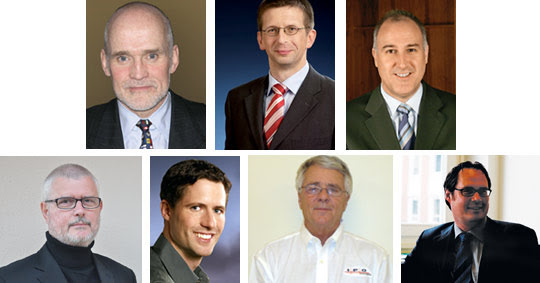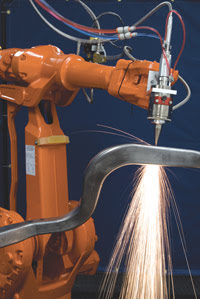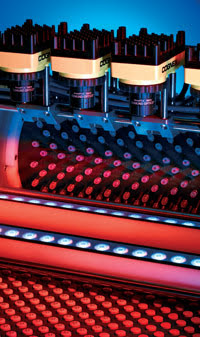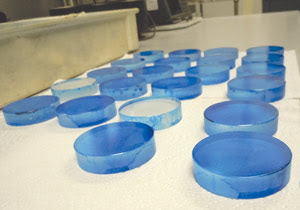A Q&A roundtable on the state and future of the photonics industry
The economy grew tremendously in 2010, according to leaders of companies in all areas of photonics – lasers, optics, imaging and beyond – who report high expectations that this growth is set to continue, especially in industrial sectors. In some cases, the growth came so suddenly that manufacturers were unprepared, having cut back on resources during the downturn the year before; others used that downtime to develop new technologies or applications for existing products.
Several companies in the past year have begun to consolidate, merging with or acquiring other companies, and some industry leaders feel that this consolidation will help the industry maneuver even faster, delivering innovation and sparking even further growth in the years to come.
Photonics Spectra reached out to some key players in the industry to gather a snapshot of the current photonics market – and to paint a picture of where that market is likely to go.

Top: Left to Right - Eugene Arthurs, SPIE - Dr. Thomas Fehn, Jenoptik and Thomas Kessler, Edmund Optics. Bottom: Left to Right - Jean-Michael Pelaprat, Vytran Corporation and OSA - Samuel Sadoulet, Edmund Optics - Bill Shiner, IPG Photonics and Simon Zilian, Trioptics GmbH.
Our panelists were Eugene Arthurs, CEO of SPIE; Herman Chui, senior director of product marketing at Spectra-Physics; Joe Delfino, VP of sales and business development at Qioptiq; Ravi Guntupalli, business manager at Princeton Instruments; Dr. Thomas Fehn, head of the Lasers & Material Processing Div. and an executive management board member at Jenoptik; Thomas Kessler, VP of global sales, and Samuel Sadoulet, VP of engineering and R&D, both at Edmund Optics; Tim Morris, general manager of Trumpf Inc.; Mike Naselaris, general manager at Sydor Optics; Jean-Michel Pelaprat of Vytran Corp. and a member of OSA’s Corporate Associates Committee; Bill Shiner, VP of industrial markets at IPG Photonics; and Simon Zilian, sales manager at Trioptics GmbH.

The photonics industry has some specific opportunities – and some specific challenges – in the current market. Smart, adaptable companies should be able to stay ahead. Photo taken at IPG Photonics’ facility in Oxford, Mass., by Laura S. Marshall.
They painted a picture of a market with specific opportunities and its own special challenges – but nearly all remained upbeat about the possibilities ahead.
Q. How would you describe the market in 2010?
Delfino, Qioptiq: Robust, relative to the overall economy. Anticipated contraction ended up to be a minor slowdown as companies reduced inventories too drastically and ended up shorthanded as a result. Supply couldn’t keep up with demand in several product areas.
Morris, Trumpf: The downturn was extremely rapid, and most of us were somewhat surprised that the recovery was almost as rapid on the way back up. The fabrication segment saw one of the largest declines but also one of the quickest recoveries. The companies that weathered the storm and used the slow period to prepare for the upturn were certainly in the best position to take advantage of opportunities in the upturn.
Chui, Spectra-Physics: In the macro- and microprocessing segments, the overall global laser market in 2010 and first half of 2011 saw a strong uptick after the downturn in 2009, as the macroeconomic environment and end markets recovered. In the biomedical and scientific segments, most laser applications continued to see steady growth in much of 2009 through the first half of 2011.
Pelaprat, Vytran and OSA: The photonics market in 2010 was recovering from the recession that occurred in late 2008 and early 2009. In 2010, we saw the recovery occur in three waves: first, at the beginning of the year, the recovery of components; next, in the second quarter, the recovery of lasers and laser systems; and, finally, at the end of the year, the recovery of capital equipment used to make lasers and components. Capex [capital expenditure] was the last to recover because companies were under capacity in the other areas.
Q: How would you describe the market so far in 2011?
Fehn, Jenoptik: At the beginning of 2011, we still had a feeling of 2010. With ongoing financial discussions, the optimism faded somewhat, but the growth is still there.

The use of fiber laser systems is growing in automotive and cutting applications. Courtesy of IPG Photonics.
Pelaprat, Vytran and OSA: In the first part of the year, we saw a continuation of growth from late 2010 through the first quarter, and then it either leveled off or declined in the second quarter. Right now, in the second half of the year, we are losing some visibility of what will happen. The market overall is essentially stagnant; companies are seeing flat growth or small growth. The big question we’re all asking is, “What is going to happen in the next six to nine months?” Because of the reduced visibility of what will happen, there is concern in the market about whether we’ll see growth through the end of the year.
Shiner, IPG Photonics: IPG … experienced tremendous growth during both 2010 and through the first two quarters of 2011. The material processing market is 86 percent ahead year over year, for example. Part of our growth is due to increasing our market share in competition with other types of lasers and retrofitting old laser machines with fiber lasers. Both the automotive sector as well as the cutting market have begun to embrace fiber technology.

Automated imaging technologies such as this pill inspection system help the pharmaceutical industry save time and money; making processes cheaper and easier for other industries will help photonics grow. Courtesy of Edmund Optics.
Sadoulet, Edmund Optics: The 2011 market had a strong beginning, but there is uncertainty in the air for the latter half. The defense spending in the US has been problematic, as has the slowdown in [semiconductors] that started in Asia this June. Psychologically, everyone is concerned about the economic health of the US, Europe and, more recently, large economies like China. Still, optics serves many expanding markets. The challenge is divorcing the newspaper gloom and doom with what should be the reality in our forecasts.
Q: Where would you say the market is going in 2012?
Guntupalli, Princeton Instruments: There is a concern about declining or flattening of research funding in the major countries around the world in 2012. Despite that, we have a positive outlook for the growth of the imaging business.
Shiner, IPG: We, like most companies, are concerned with the current worldwide economic situation, and if this is not resolved, it could adversely impact 2012 sales and investment in capital equipment. The current growth sectors during 2010 and 2011 have been automotive and the solar industry. We already are seeing signs in Europe and the US of the solar industry slowing down, while automotive remains strong.
Delfino, Qioptiq: Overall, [the market will be] stable – with declines in defense/ISR [intelligence, surveillance and reconnaissance] markets and modest growth in the commercial markets. Increasingly sophisticated medical design/product growth will contrast reduced expectations in life sciences and semiconductors. All industries will increasingly focus on their core competencies and turn to optical suppliers for subsystem engineering and optimized assembly solutions.
Pelaprat, Vytran and OSA: Predictions range from seeing a small downturn to flat growth. Companies aren’t anticipating significant growth overall, but rather a mix of growth, stagnation or decline, depending on the market segment. For example, fiber lasers and instrumentation are likely to grow faster than traditional laser technology. In general, most companies are preparing for flat or slight declines in 2012. One indicator of this is the activity we’re seeing in Asia. The market in China has not been growing as much as it had been in the past few years, so people are anticipating the overall market will mirror this in 2012.
Kessler, Edmund Optics: In the US domestic market, you can expect months of slow demand because we are going into an election year. The uncertainty fuels indecision, which is not good for industry. Asia, however, will continue to grow well – particularly in imaging and life sciences. Also, Japan is on a good recovery path from the earthquake, the tsunami and the consequent impact on its domestic production. We are not expecting huge gains in Europe at this point, but expect that market to be stable. The greatest uncertainty in Europe centers on the debt situation in Greece.
Zilian, Trioptics: The market will grow slowly, due to the growing economy. The defense and security market is expected to grow. Also, the Asian market is still growing and will continue to do so in 2012. In Asia, China is one of the biggest growing markets in optics.
Morris, Trumpf: We are still bullish regarding 2012. I don’t expect the growth we have experienced in 2011 to continue at the same pace; however, backlogs are still strong, and the project outlook is still very encouraging across all industrial sectors.
Q: Where do you think the market will go in the next five years? How about the next 10?
Naselaris, Sydor Optics: Based on the financial problems of the world, I am guarded of being overly positive – yet at such a rapid rate of technology advances, I do see steady growth over the next five years. As for 10 years out, I think the market will continue to grow for optics. All new technologies, in some way, shape or form, have been touched by optics. Whether on the systems level or the component level, optics are becoming an even larger part of tomorrow’s technologies.

Diode lasers, seen here in the electroplating stage of manufacturing, can be used in a variety of high-power applications, from aesthetics to industrial. Courtesy of Jenoptik.
Delfino, Qioptiq: Expectations are for a broad migration of talent from optical defense markets to commercial markets, with an emphasis on medical and bio organizations and markets. Stabilization in the wider economy, combined with continued improvements with LED and laser source power/price, will lead to broader commercialization of high-volume applications.
Guntupalli, Princeton Instruments: Imaging will continue to grow as a cross-functional area, with new techniques being developed or old techniques being used in a novel way. For example, adaptive optics developed in astronomy is finding uses in microscopy for real-time focus corrections. Another example: Raman spectroscopy is being used more and more by biologists for disease detection.
Kessler, Edmund Optics: While we expect the overall market to grow slowly, there will be innovative areas with a more significant – even double-digit – growth. Among these are the biotech and health sectors, photovoltaics and imaging in automation. In 10 years, we will see new markets created by new applications that can hardly be predicted today.
Zilian, Trioptics: In the next five years, the market will grow slightly; this depends on the global economy. Optics are used in so many fields; one sector will compensate the growth of another sector.
Fehn, Jenoptik: The trends which govern laser applications today will become stronger and more visible: health and aesthetics, micromachining and improving efficiency in macromachining with high-power laser sources. This favors all-solid-state laser and diode-direct solutions and encourages laser suppliers to offer tools designed for applications both in specifications and costs.

All-solid-state-lasers are set to grow for health applications as well as micro- and macromachining. Courtesy of Jenoptik.
Chui, Spectra-Physics: The prospects for lasers appear very promising in the five- to 10-year time frame. With the advancement of laser technology and applications, we are seeing lasers drive three trends: 1) dramatic but evolutionary improvement in existing laser processes in terms of productivity and cost; 2) replacement of nonlaser processes, where lasers were not previously compelling in performance or cost; and 3) enablement of entirely new processes and applications not previously possible without lasers.
These trends span across most all market segments, including macro- and microprocessing, and biomedical. For example, in microprocessing, advances in lasers are resulting in significant increases in laser processing throughput in solar, [printed circuit board] and display manufacturing, while at the same time in other processes for the same manufacturing lines, lasers are replacing mechanical tools and being investigated for entirely new processes and structures.
Pelaprat, Vytran and OSA: I wish I knew. If I knew where the market was headed in five or 10 years, I could make a lot of money! In all seriousness, it is too difficult to predict, as there are so many possible scenarios based on what we’ve seen in the past few years. We could see another recession, we could see stagnation, or there could be new markets and applications we’re not aware of yet.
The photonics market, with the exception of the telecom segment, is not known for having big booms, so I don’t think we will see any major applications in the next five or 10 years that cause huge growth like what we saw with telecom in the early 2000s. If I had to predict, overall, I would say to expect a modest growth over the next five years.
Q: What are the current challenges for the market?
Delfino, Qioptiq: There are many challenges, depending upon your area of expertise, markets and proper allocation of resources. The uncertainty created by the overall bearish economy adds a more complex dimension. Companies in the optics market need to understand how to innovate while adding value and create a sustaining, competitive plan during an ever-changing global economic landscape.
Guntupalli, Princeton Instruments: There is no one imaging technology that can meet the demands of diverse applications. Detectors capable of single-photon counting from x-ray to NIR wavelengths will emerge based on silicon (CCD and CMOS) and infrared materials.
Fehn, Jenoptik: New laser applications, in most cases, are substitutions ... for other laser applications. It is hard to find applications which have not been there before, are suitable for lasers and offer a decent market volume. But these applications will broaden the market substantially.
Morris, Trumpf: The use of lasers in the industrial materials processing segment – for example, high-volume cutting and welding – continues to see increased acceptance in North America. However, North America continues to lag behind Europe and Asia in this regard. One of the challenges is educating the relative manufacturing segments as to the capabilities and cost-effectiveness of today’s laser products.
Naselaris, Sydor Optics: Steady supply and competitive pricing of cerium oxide polishing compounds. This past year has had a considerable effect on pricing of optics and our margins. Timely delivery of glass has also played a role this year in our growth. The busier the industry gets, the longer lead times are for optical materials, which make it more difficult to quote to our customer’s needs. Overseas competition, primarily with China, as their quality continues to increase.
Q: What are the current growth sectors in the market?
Kessler, Edmund Optics: The current growth sectors in the optics market lie in the life sciences and imaging in automation. The biotech and health sectors are increasingly interested in optical techniques for biological research and medical diagnostics. The manufacturing sectors are looking to increase production capacity and yield by leveraging machine vision at ever-higher speeds and resolution levels. The needs in these sectors will both grow the market and stimulate innovation in optical technology as well as production efficiency.
Naselaris, Sydor Optics: We have seen the largest growth primarily in biomedical applications involving filter substrates and wafer-based technologies. Filters are manufactured today that far outperform traditional colored glass filters and are much more durable. As for wafer-based technologies, there are more and more applications using semiconductor technology for micromechanical components, micro-optics, microfluidics photolithography and wafer-level packaging.
Guntupalli, Princeton Instruments: Life sciences, nanotechnology [and] quantum computing are just a few fields which will drive growth.
Fehn, Jenoptik: The aesthetics market and the micromachining market showed substantial growth, and we see this to be continued, but we will also take part in the high growth rates within the high-power applications, driven by our competence in high-power diode lasers and fiber lasers.

The crystal ball is a little cloudy for the next five to 10 years – but optics and other photonic technologies touch so many parts of so many different industries that experts predict at least mild growth. Photo of Sydor Optics products by Laura S. Marshall.
Shiner, IPG Photonics: We are very optimistic regarding the next five years. IPG currently has 15 percent of the material processing market, and we will continue to increase our share over the next five years.
Chui, Spectra-Physics: Cyclicality in various end markets notwithstanding, we are seeing growth sectors for lasers spanning a number of industries. In biomedical, growth sectors include biological imaging, molecular diagnostics and therapeutic applications. For microprocessing, growth sectors include laser processing for flat panel displays, LEDs and solar manufacturing. Macroprocessing growth segments include metal processing in electronics and industrial applications.
Pelaprat, Vytran and OSA: Lasers and LEDs in displays have the potential for growth, and I believe the next two years will be critical. For example, laser displays are being deployed in movie theaters worldwide. While that is a large market segment, it’s confined to a set number of projectors based on the number of theaters. However, it could expand into consumer applications and grow from there. A similar situation is occurring in the LED segment. There is growth in digital signage and displays, which could grow even further, once it takes off in the consumer arena.
Q. A number of companies are buying or merging with one another lately, it seems – what does this apparent trend of consolidation mean for the industry?
Zilian, Trioptics: [This] is a global trend which is not just limited to the optical market. Companies will specialize on their core competences. This will lead to advanced products and competition between few companies.
Guntupalli, Princeton Instruments: There seem to be more mergers and acquisitions of late than before (e.g., Bruker-Caliper, Teledyne-Dalsa, BAE-Fairchild). I think the trend will continue, especially if there is continued slowdown in the economy – that makes buying companies attractive. On the positive side, consolidation [gives] smaller companies with promising technologies/products much wider scope with needed capital and distribution. This should benefit the customer. On the other hand, the consumer choice will be limited.
Naselaris, Sydor Optics: My views are biased toward business growth, whether ours or others’; therefore, I am a believer in mergers. There are good reasons from both sides of the equation – the buyer and the seller – for the merger, which include an exit strategy from business owners/ founders, joining of forces to make the group more competitive, acquiring needed or wanted technical capabilities and/or capacities, buying out a competitor, et cetera. After all, the job of business management is to maximize profits and increase competitive, sustainable advantages, and this is a viable method of doing so.
I believe the momentum will remain stable for a few years at least. I do not foresee any real changes to the market at this time, based on the level we are at with mergers. We are far from having just a few larger companies making all the optics with few or no smaller companies left behind.
Arthurs, SPIE: Consolidations, mergers and acquisitions in the photonics industry over the past year have primarily been about adding strength to strength: enhancing R&D or manufacturing capabilities, adding talent and expanding into new segments or geography. Companies have sought synergies that result in more products to sell to current customers, fast entry into emerging opportunities, or diversification. In some cases, companies have been able to reduce costs by increasing purchasing volume or eliminating a layer of markup in the supply chain. There have been substantial customer benefits as a result of economies of scale or vertical integration lowering costs and accelerating delivery. Some companies have been able to bring capabilities in-house that were formerly provided by vendors who also served their competitors, and thereby create a more reliable supply and force their competitors to look elsewhere. These types of realignments contribute to a stronger industry overall, fostering a creative environment in which disruptive new technologies can be moved to market more quickly and in more diversified ways.
Even in the face of large companies growing larger, there is still opportunity – and even a pressing necessity – for small and medium-sized enterprises to flourish. The demand for new photonics applications is only increasing, and venture capital continues to be available for entrepreneurs with well-prepared plans for innovation around major challenges such as bandwidth expansion, cost-effective health care, lasers in manufacturing and automobiles, sensors for evaluating aging infrastructure, threat detection and security using new devices, and more.
This wave of consolidations and mergers raises the profile of the industry and is having a positive influence on market evolution.